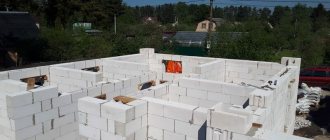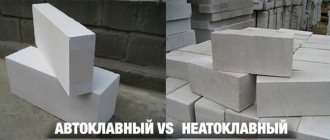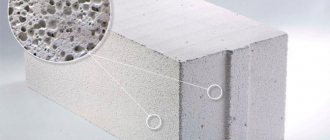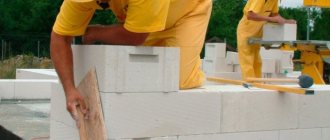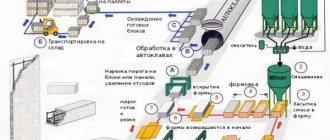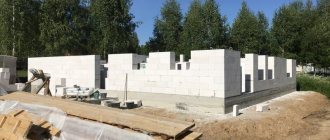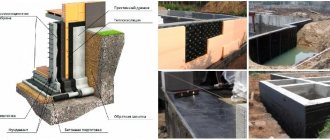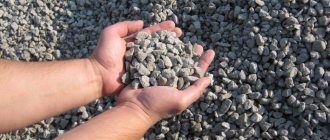Autoclaving of aerated concrete
Recently, due to the growing popularity of building blocks made of cellular concrete, the question often arises: what is the difference between autoclaved aerated concrete and non-autoclaved materials (foam concrete and non-autoclaved aerated concrete)? We will try to answer this question in this article.
Several terms are common for building materials made of cellular concrete - aerated concrete, foam concrete, in addition there are characteristics such as autoclave and non-autoclave. Let's look at the definitions. Cellular concrete is the general name for all lightweight concrete, which is characterized by the presence of many pores (cells) in its structure, which impart improved physical and mechanical properties to the material.
According to the method of pore formation, cellular concretes are divided into foam concretes
and
aerated concrete
.
As the name suggests, one material uses chemical foam
, while the other
uses gas
.
Foam concrete is a cement-sand mortar frozen in a porous state. The cellular structure in it is formed by introducing and “beating” chemical foaming agents. As a rule, a workshop for the production of foam concrete (“a factory” is extremely difficult to call this factory), small in area with a predominance of manual labor and unqualified personnel. The production volume is extremely small, the turnover of funds is low, so in such production you have to save on literally everything, which clearly does not contribute to improving the quality of the finished product.
Saturation of concrete with gas released during the reaction of lime and aluminum paste is a rather complex process and requires careful control over the dosage of these components. This can only be achieved in large factories with high-quality automated equipment, and until recently the term “aerated concrete” already by default meant the presence of autoclave processing. So gradually a stable and completely objective opinion formed in the minds of the consumer: foam concrete is cheap and has mediocre characteristics; aerated concrete is a little more expensive, but the quality and stable properties are much better.
In the competition for the buyer, foam concrete manufacturers, instead of reducing prices or improving the quality of their products, decided to simply move away from the completely discredited term “foam concrete”, replacing it with a more euphonious one - NON-autoclaved aerated concrete. In essence, the material has not changed, now a little gas-forming agent is added to the same chemical foam, then everything is also poured into the formwork and the solution gains strength in the open air. For the end consumer, apart from increasing the price of the product, this renaming does not bring anything.
What is autoclaving and why is it needed?
Autoclave processing - steaming in metal capsules (autoclaves) at high pressure (12 atm.) and high temperature (191 ° C) - allows you to obtain a material with properties that cannot be obtained under normal conditions. Autoclaving of aerated concrete is carried out not only to speed up the hardening process of the mixture. The main idea is that in an autoclave, changes occur in the structure of aerated concrete at the molecular level, and a new mineral with unique performance characteristics is formed - tobermorite. Therefore, autoclaved aerated concrete is an artificially synthesized stone
, and
non-autoclaved concrete
a cement-sand mortar
frozen in a porous state .
Autoclaved aerated concrete and non-autoclaved materials differ fundamentally in a number of parameters, ranging from composition to physical, technical and operational characteristics. To be more precise, autoclaved aerated concrete surpasses them in all respects.
Let's look at the main indicators:
Aerated concrete production technology
Before talking about significant differences in the properties and quality of autoclaved aerated concrete and naturally cured blocks, let’s consider their component composition, which is absolutely identical:
- additive-free Portland cement grades M300, M400, sometimes M500 is used;
- clean sand of fine fractions - from 2.0 to 2.5 mm.
- water of medium hardness without chemical impurities;
- gas generator - aluminum powder or paste;
- a substance that triggers chemical swelling reactions - lime, the type, condition and dispersion of which depends on the production method;
- modifiers that improve the quality of the final product are added at will and are not mandatory components.
Another similarity that unites autoclaved and non-autoclaved aerated concrete is the principle of mortar production.
At the first stage, in accordance with the technology, an ordinary cement-sand mortar of the required consistency is prepared. The resulting mixture is distributed over the formwork. After which aluminum powder and lime are introduced into it. It is the reaction of these components that ensures the formation of gas; the solution swells, forming pores.
Further technologies diverge at the stage of curing and processing of aerated concrete. During natural hardening, the finished solution is poured into formwork, forming blocks of the required size. After gaining strength, the products are stripped and sent to the finished product warehouse.
When using an autoclave for aerated concrete, this stage is a little more complicated. Namely, the mixture is poured into monolithic formwork. After swelling and gaining minimum strength, the aerated concrete block is cut into products of the required sizes and sent for additional firing in an autoclave, where the temperature is maintained at 200 0C and a pressure of 10 Bar. Such conditions activate cement hydration processes to the maximum and allow excess moisture to be removed from concrete.
As a result, it turns out that naturally dried products are just a hardened expanded cement-sand mixture, when autoclaved aerated blocks during the firing process form a new synthetic component - tobermorite, which qualitatively improves the characteristics of the final product.
Stability of the quality of autoclaved aerated concrete
Autoclaved aerated concrete is produced only in large-scale production and arrives at the construction site in the form of finished blocks. The production of autoclaved aerated concrete in artisanal conditions is impossible, since during production it is necessary to simultaneously control several dozen processes and parameters. Modern autoclaved aerated concrete plants have a high degree of automation (about 95%) and practically eliminate the influence of the human factor on the production process.
Autoclaved aerated concrete is produced in accordance with modern GOST 2007, which is confirmed by test reports, the products have a quality certificate, and the client can be sure of the proper quality.
The production of foam concrete and non-autoclaved aerated concrete does not require a large plant and huge capital investments, which ensures a low barrier to entry into this business. In practice, this means that having a small concrete-mortar plant, formwork and a couple of low-skilled workers, you can organize a handicraft production with unstable quality indicators, proudly calling it a plant or factory for the production of building materials. It is almost impossible to ensure the stability of product characteristics under such conditions, since the dosing of components is done manually and, as a rule, “by eye,” and the old GOST, which is more than a quarter of a century old, allows the production of such products.
Characteristics of autoclaved and non-autoclaved aerated concrete
Today, builders are increasingly resorting to the use of modern, lightweight materials that are not inferior to traditional ones. These include aerated concrete. Blocks are produced using two methods – non-autoclave and autoclave. What is the difference, how do the materials differ, and most importantly, which one is better to prefer?
Fake diamond
Aerated concrete, artificial stone, is one of the subtypes of cellular, lightweight concrete, in which pores with a diameter of 1-3 millimeters are distributed throughout the volume. Thanks to its structure, this building material has the characteristics for which modern architects value it. This:
- light weight;
- excellent heat and sound insulation properties;
- ease of processing (even with the simplest tools);
- frost resistance.
It also has the advantage of fire safety, environmental friendliness, ease of production and an affordable price for the consumer. Based on the finishing method (hardening conditions) of the cut blanks, aerated concrete is divided into autoclave and non-autoclave.
What to choose?
Experts advise choosing autoclaved aerated concrete.
When choosing aerated concrete, experts clearly advise giving preference to autoclaved concrete, citing comparisons with baked and unbaked bread for credibility.
These materials differ from each other in many respects - composition, technical characteristics, operational capabilities. It is interesting that in 2007, autoclave products received their own modern GOST standards, which placed them in a separate class.
But manufacturers of non-autoclave products remained the same, approved back in 1989. The new standard for baked materials is in line with the European standard for masonry products.
Autoclave products are distinguished by much higher levels of strength and uniformity . It does not shrink significantly; the finished blocks have precise geometry. Such material is produced in factories and delivered to construction sites ready-made. Aerated concrete, which hardens naturally, can be made directly at the construction site. However, failure to comply with the technology will significantly affect the quality.
Mixture composition
The composition of autoclaved aerated concrete includes:
- cement;
- lime;
- quartz sand;
- aluminum powder (as a result of the reaction of its aqueous suspension with lime, hydrogen is released, due to which bubbles appear in aerated concrete).
A small amount of gypsum is also added to slow down the thickening of the mixture.
Technology
The composition is mixed automatically. Next, it is poured into molds (approximately half). As the mass thickens, it rises to the edges, this takes about an hour or two. After this, the aerated concrete is cut into blocks using special equipment and sent to an autoclave oven for twelve hours. There, at an increased pressure of 12 atmospheres, it is treated with water vapor heated to a temperature of 190°C, acquiring the required strength.
Features and benefits
Autoclave production of blocks gives them a number of special advantages. Among them:
- high thermal insulation properties (several times better than conventional brick);
- good sound insulation;
- resistance to moisture, mold;
- correct shape, which allows for smooth masonry and finishing;
- ease of processing, speed of installation;
- minimal shrinkage during construction.
Flaws
The disadvantages of autoclave blocks include their certain fragility (it is necessary to handle the material carefully during loading and unloading, transportation and direct installation). Also, to work with such walls, special fasteners are required, ordinary dowels, screws, self-tapping screws - there are no helpers here.
Conclusion. Aerated concrete, “hardened” in an autoclave, is a good and relatively inexpensive alternative to traditional building materials. It is produced in a factory, which provides for quality control of finished blocks. However, as experts note, their installation must be done correctly, in compliance with technology.
Compound
The composition of non-autoclaved lightweight concrete includes:
- Portland cement;
- sand (pure or with an additive in the form of fly ash remaining after combustion of solid fuel at thermal power plants);
- aluminum powder (as in autoclave production, it is used as a blowing agent);
- calcium chloride (accelerates the hardening process);
- various additives.
Advantages and features
Among the advantages of non-autoclaved “bricks” is the ability to produce them directly on construction sites. In addition, due to the closed shape of the pores, the walls will not absorb moisture - this quality is valued where flooding occurs after winter. Another plus is lower cost.
Conclusion. Working with non-autoclave materials is also simple. They have a number of disadvantages compared to factory units, but manufacturers are now improving the quality and strength of products. Craftsmen also warn that there is a risk of running into handicraft blocks, but it is easy to identify “shortcomings” - such aerated concrete crumbles considerably.
Source: https://kladembeton.ru/vidy/gazobeton/avtoklavnyj-i-neavtoklavnyj-gazobeton.html
Strength
Cellular concrete is produced in various densities: from 400 to 800 kg/m3 with a compressive strength class from B1.5 to B7.5. The most popular densities are D500 and D600, while autoclaved aerated concrete at these densities has a compressive strength class of B2.5 and B3.5, respectively.
Non-autoclave materials are significantly inferior to autoclaved aerated concrete in terms of physical properties and strength at the same density. For example, with a density of D600, they have a compressive strength two times lower than that of autoclaved aerated concrete! In addition, manufacturers of non-autoclave materials simply cannot produce building blocks with a density below D600, because These blocks have no strength at all, and their use in construction is unacceptable.
Properties of non-autoclaved and autoclaved aerated concrete
The resulting blocks, made using two different technologies, are so different both in appearance and in their characteristics that even an inexperienced layman can distinguish them from each other.
External indicators
The first thing the buyer encounters when choosing is the appearance of the materials. It would seem that it makes no difference what the wall blocks look like, which still need to be plastered later. However, appearance is the most accurate visual characteristic that will help weed out low-quality products.
Geometric dimensions
If we compare gas blocks based on geometry, then autoclave-cured products are more accurate. This is partly due to autoclaving and, of course, cutting technology. Even GOST standards regulate deviations of linear dimensions from nominal ones in different ways, depending on the production method used.
| Permissible deviations according to parameters | Autoclaved aerated concrete | Non-autoclaved aerated concrete |
| Length, mm/m | 3 | 5 |
| Width, mm/m | 2 | 4 |
| Height, mm/m | 1 | 2 |
These data only highlight the fact that autoclaved aerated concrete is distinguished by the precise geometry of the finished products, which prevents:
- freezing of walls due to thickening of the masonry seam, which compensates for deficiencies in the shape of the blocks;
- overconsumption of masonry adhesive, leading to increased costs.
Color
When purchasing blocks, pay attention to their color. Of course, it will be gray in the case of naturally hardening products and almost white in autoclaved aerated concrete. Differences in block shades and color variations indicate changes in the manufacturing process, which often result in reduced performance.
Automated equipment for the production of autoclaved aerated concrete reduces any errors to zero, which is initially considered a guarantee of quality and durability. In addition, such large-scale workshops are complemented by their own construction laboratory, in which timely testing is carried out to identify inconsistencies in technology or recipes.
Physical and mechanical properties
Aerated concrete blocks differ not only in external characteristics and color, but also in physical and mechanical properties.
Strength
Aerated concrete is represented by a wide range of strength grades - from B1 to B7.5. They are widely used not only to create load-bearing structures, but also to insulate walls. If we compare aerated concrete produced using different technologies, autoclave concrete is more durable at the same density as non-autoclave concrete.
For example, blocks with a density of D600 must have a strength class of B3.5. If for autoclaved products the indicator is met, then with naturally seasoned products the strength class hardly reaches half the norm. The situation is even worse with the strength indicators of aerated concrete produced by hand. If you want to see this for yourself, buy a block and have it tested by an independent construction laboratory. The results will be obvious.
Thermal conductivity
The thermal conductivity of aerated concrete directly depends on the density of this material. The lower the density grade of the block, the better its heat capacity properties. It makes more sense to purchase products of lower density, but with higher strength characteristics, thereby reducing the thermal conductivity of the walls.
Shrinkage
The weakest side of any cellular concrete is its shrinkage after the walls are erected. If the wrong construction technique is used, cracks may appear and the plaster layer may peel off. The shrinkage processes of naturally aged aerated concrete can last up to several years, when autoclaved blocks are practically free of such a drawback, since during heat and humidity treatment they have already achieved brand strength and complete drying.
In addition, seasoned aerated concrete blocks under natural conditions are far from ideal, which negatively manifests itself in the form of shrinkage. This not only leads to a violation of linear dimensions, but also to destruction of the structure.
To summarize, we can easily conclude that autoclaved aerated concrete blocks have undeniable advantages over naturally cured products. But in any case, when purchasing such wall material, always ask for documents certifying its quality.
Possibility of fastening
Autoclaving significantly increases the strength characteristics of aerated concrete. Not only cabinets and shelves, but also boilers, air conditioners, and ventilated facades can be attached to a base made of autoclaved aerated concrete Moreover, curtain facades can be made of either light composite or heavy porcelain stoneware. For this purpose, anchors with polyamide expanding elements are used. For example, one 10x100 anchor can withstand an axial pullout load of up to 700 kg, which is quite comparable to the performance of solid brick or heavy concrete.
There is simply no need to talk about fastening into foam concrete or non-autoclaved aerated concrete. The nail or screw is simply pressed into the wall by hand, so the use of conventional mechanical fasteners is not possible here. An expensive two-component chemical anchor can be used to attach non-heavy objects, such as mirrors or coat hooks, which gives at least some illusion of reliability. But when hanging a kitchen set on the wall, even the use of “chemistry” will not help, because... under the weight of the cabinet with dishes, the non-autoclave material will collapse at the attachment point and a piece of the block will simply fall out of the wall.
Uniformity
During the production of autoclaved aerated concrete, gas formation occurs simultaneously throughout the entire volume of the material. In parallel with gas formation, curing occurs. As the mass grows, a pulse is periodically applied to the formwork from special vibrators attached to it, which “shakes” the mass, expelling large gas bubbles from it and eliminating the presence of shells and air bags in the finished blocks. As a result, the pores are of the same size and evenly distributed throughout the entire volume of the material. Building blocks from autoclaved aerated concrete are obtained by cutting a large mass, which guarantees the ideal and identical quality of all blocks.
Non-autoclaved aerated concrete and foam concrete
obtained by introducing foam and gas-forming agents into the concrete mass and mixing it.
As a result, it often happens that bubbles, like the lighter components of the mixture, float up, and the heavier fillers settle down
.
The result is an uneven distribution of pores in the block
, and due to this it is not possible to achieve uniform characteristics on different blocks. The technology for producing non-autoclaved aerated concrete eliminates the possibility of shaking the mass, so the presence of bubbles with a diameter of 50-70 mm is common. In such material, colder sections of the wall often appear with condensation on the surface, as well as cracks in places where the masonry is weakened by large air bubbles.
Comparison of autoclaved and non-autoclaved aerated concrete, differences and characteristics
Aerated concrete can be autoclaved or non-autoclaved, and many builders wonder what the differences are between them.
Let's figure this out together, but looking ahead, let's say that autoclaved aerated concrete is a much higher quality material, and then we will tell you why.
What is autoclave processing of aerated concrete?
Autoclave processing is the stage of processing aerated concrete at high temperature (190°C) under high pressure for 12 hours . Autoclaves are metal containers into which cut gas blocks are placed.
Autoclaving is done for the following purposes:
- acceleration of aerated concrete hardening;
- increased strength;
- reduction of shrinkage;
- improvement of structure homogeneity;
- improvement of block geometry.
The autoclave also changes the structure of aerated concrete at the molecular level, forming a new material - tobermorite . This synthesized stone has properties that cannot be obtained under normal conditions at standard pressure and temperature.
Let us repeat that non-autoclaved aerated concrete hardens under natural conditions, and expensive and modern equipment is not required for its production. In other words, many manufacturers stamp gas blocks in their garages, which does not inspire much confidence.
Now let’s take a closer look at the differences between aerated concrete, and we’ll start with strength.
Comparison of autoclaved and non-autoclaved aerated concrete
It is important to note that the video tests non-autoclaved aerated concrete, to which fiber fiber has been added; it significantly increases the strength of the blocks. But we note that in reality, not everyone uses fiber in the production of non-autoclaved aerated concrete, since it is quite expensive.
Drying shrinkage
The strength gain of non-autoclaved cellular concrete is accompanied by significant shrinkage, which, in turn, leads to cracking of the finished masonry. Very often we see how multiple cracks appear on a newly built and finished building, the finishing layer peels off, and the plaster falls off. These processes can take place over several years - the same period while the “strength is gaining.”
Moreover, the blocks are riddled with cracks even before they are laid into the masonry. You can only get rid of shrinkage and cracks by autoclaving, but in artisanal production this is impossible. Therefore, sellers of foam concrete and non-autoclaved aerated concrete use marketing tricks by adding fiber (paper impregnated with a solution of sulfuric acid and calcium thiocyanate) and calling it “reinforced foam concrete” that is resistant to cracking. For the end consumer, again, apart from increasing the cost, fiber does not provide anything, because anyone, even not associated with the construction industry, understands that if you add paper to concrete, then the material will not have any miraculous properties promised by foam concrete sellers.
It should be noted that the lighter (and, as a result, warmer) the material, the greater the shrinkage. Construction experience shows that walls made of non-autoclaved cellular concrete cannot simply be puttyed and painted - they have to be covered inside with plasterboard, and for external finishing, curtain facades must be used with fastening to the ceiling or brick.
Autoclaved aerated concrete has fully gained strength already during the production and autoclaving process, so it is not threatened with shrinkage deformations.
For example, for autoclaved aerated concrete the shrinkage rate does not exceed 0.4 mm/m, while for non-autoclaved materials it is 10 times more - up to 5 mm/m.
Autoclaved and non-autoclaved aerated concrete
You should definitely take a few minutes of your time to read this important article. Today we will tell you the whole truth about autoclaved and non-autoclaved aerated concrete (or rather, about its production):
popular every year ?
— What is the difference between autoclaved aerated concrete and non-autoclaved one?
— Why is the payback period for a business in the production of non-autoclaved aerated concrete at least 20 times less than in autoclave production?
— Why is non-autoclave production much more profitable for manufacturers?
So, which is better: autoclaved or non-autoclaved aerated concrete? Read our article and you will find out everything!
Autoclaved and non-autoclaved aerated concrete: comparison
1. Production technology
The main component of autoclaved aerated concrete is lime, which hardens only with special treatment. For this purpose, autoclaves are used - hermetically sealed devices in which a constant temperature ( 180-200C ) and pressure ( 12-14 atm ) are maintained. Hardening of autoclaved aerated blocks occurs within 12 hours .
The main component of non-autoclaved aerated concrete is cement, which is mixed with a filler (sand, fly ash from thermal power plants, dolomite flour, etc.) and a gas-forming agent (aluminum powder/paste). To harden such aerated concrete blocks, it is necessary to achieve a temperature of only 40-60C (simple heating chambers are used for this). The required time to gain initial strength is 6-10 hours .
2. Cost
Starting autoclave production will require huge financial investments. For example, the minimum cost of Chinese equipment is $1,500,000 . It is worth considering the fact that you are unlikely to receive full technical support.
If we consider high-quality equipment from German manufacturers, then the cost of a line with a capacity of 200 cubic meters of aerated concrete per day will be approximately more than $6,000,000 !
A line for the production of non-autoclaved aerated concrete can be purchased for $85,000 . This is the cost of equipment with maximum productivity - 200 cubic meters per day. At the same time, a line with minimal productivity can be purchased for only $3,000 .
3. Equipment manufacturing time
If you want to organize a business “here and now,” then autoclave production is definitely not for you. The production time for autoclave equipment is at least 1 year (and on average 1.5 years) after the official conclusion of the transaction.
The production and delivery time for equipment for the production of non-autoclaved aerated concrete is on average 10-30 days .
4. Energy costs
Energy consumption in autoclave production is tens of times higher. For example, the power of the electric motor of a ball mill is about 100 kW , and this is mandatory equipment in autoclave production. Now imagine how much energy is needed to maintain temperatures in autoclaves of up to 200 degrees and pressure of up to 14 atmospheres !
Environmental friendliness
Autoclaved aerated concrete is an absolutely environmentally friendly and air-permeable material. Therefore, in a house made of autoclaved aerated concrete there is always a favorable microclimate for living, similar to the climate of a wooden house. Aerated concrete is made from mineral raw materials, therefore it is not at all susceptible to rotting, and due to the ability to regulate air humidity in the room, the likelihood of fungi and mold appearing on it is completely eliminated.
Foam concrete can be made from the cheapest local raw materials: sand, waste from crushed stone production, in addition, chemical additives are used as foaming agents, which undoubtedly reduces the environmental friendliness of a house made of foam concrete. Also, chemical components are introduced into the block with fiber impregnated with acids, chlorides and thiocyanates. Even present in small quantities, these substances can be released and accumulate in the air of residential premises.
Geometry
Accuracy of block geometric dimensions
made of
autoclaved aerated concrete is regulated by modern GOST, permissible deviations are up to 3 mm in length, up to 2 mm in width, and up to 1 mm in thickness.
The blocks are obtained by cutting a large mass of autoclaved aerated concrete with strings, and it is simply impossible to cut unevenly with such equipment. Non-autoclaved aerated concrete and foam concrete are poured into formwork with limited cycles of use. Due to the same savings, the formwork is used several times longer than its standard service life, and since the formwork is dismountable, due to its deformation and wear, it becomes more and more difficult to assemble it correctly each time - hence the deviations in the geometry of the blocks. For non-autoclaved aerated concrete and foam concrete, deviations in geometric dimensions are allowed significantly more - the thickness can reach 5 mm (old GOST of 1989).
A large variation in the geometric dimensions of blocks made of non-autoclave materials leads to a deterioration in all masonry parameters:
- - the thickness of the mortar layer increases, leading to an increase in the cost of masonry
- - shrinkage of the masonry increases, because In addition to blocks, thick mortar joints are also shrinked
- - cold bridges form due to thick mortar joints
- — labor-intensive leveling of the vertical surface of the walls is required
- — the consumption of cement-sand mortar is 5-6 times higher than masonry adhesive
- — the thickness and labor intensity of finishing work increases
- - the strength of the masonry decreases
Thermal insulation properties
The density of foam concrete or aerated concrete directly affects their thermal insulation properties and the denser the material, the lower the thermal insulation. Foam concrete or non-autoclaved aerated concrete with low density is an excellent thermal insulation material, but its strength is extremely low and cannot be used for laying walls. As a structural material, especially for load-bearing walls, a higher density is required, which means the material will be “colder”. For example, for the Irkutsk region, when using non-autoclave materials, the density of cellular concrete should be at least 700 kg/cubic. meter. The already outstanding thermal insulation properties are significantly worsened by masonry using cement-sand mortar with thick seams. This means that the thickness of a wall made of foam concrete or non-autoclaved aerated concrete with a density of D700 for normal thermal insulation without the use of insulation should be about 65-70 cm.
A wall made of autoclaved aerated concrete provides the same thermal protection and strength
with a thickness of only 40 cm
, while a density of D400-D500 is sufficient.
Objectively, autoclaved aerated concrete has better strength and thermal insulation characteristics than non-autoclaved materials and is lighter in weight.
Let's sum it up
- — Autoclaved aerated concrete is superior to non-autoclaved materials in terms of physical and technical properties due to autoclave processing.
- — Autoclaved aerated concrete is produced only in modern factories with stable, guaranteed quality at the level of world standards.
- — Autoclaved aerated concrete differs from non-autoclaved materials in its higher strength and lower weight.
- — Autoclaved aerated concrete does not shrink during operation.
- —
Blocks made of
autoclaved aerated concrete are distinguished by precise dimensions and uniform mass density. - — Autoclaved aerated concrete is an artificial natural mineral, which determines the highest level of its environmental friendliness.
- —
The use of
autoclaved aerated concrete allows you to build a heat-efficient house with a uniform 400 mm wall that does not require insulation.
Building houses from non-autoclave materials is cheaper only at first glance. If we take into account the poor geometry of non-autoclave materials, worse thermal insulation and strength indicators compared to autoclaved aerated concrete, and the need for greater consumption of masonry and leveling materials, then there is no benefit in building from non-autoclave materials.
